1980 SKODA 120 LSE light
[x] Cancel search: lightPage 48 of 238
![SKODA 120 LSE 1980 Workshop Manual Nominol
diometer
mm Gudgeon
pin
diometer mIn Pin
bore
in piston
nl
n] Connecting
rod
smoll-end bore
(br-rsh diometer)
mm
20
20.0s 20
-
0.003
20.0s --
0.003 -
0.004
zu - o.o1o
,o 05, 3 3 SKODA 120 LSE 1980 Workshop Manual Nominol
diometer
mm Gudgeon
pin
diometer mIn Pin
bore
in piston
nl
n] Connecting
rod
smoll-end bore
(br-rsh diometer)
mm
20
20.0s 20
-
0.003
20.0s --
0.003 -
0.004
zu - o.o1o
,o 05, 3 3](/manual-img/3/57425/w960_57425-47.png)
Nominol
diometer
mm Gudgeon
pin
diometer mIn Pin
bore
in piston
nl
n] Connecting
rod
smoll-end bore
(br-rsh diometer)
mm
20
20.0s 20
-
0.003
20.0s --
0.003 -
0.004
zu - o.o1o
,o 05, 3 3?3 2a
13 33?
,o os
13
33?
Toble
ofMotching GudgeonPins
to Pistons ond
Smoll'end Bushes The
cler
should be
cleoronce
the rings
2.11 COn
The con
o brorrze
b
beoring sh
in the big
Before r
for compli<
weight, ol
ond motch
shoft.
For its
<
ter 2.12.
To Check
Connecti
weight gror
foctory, ligl
yellow poi
Should the
during stor
been fitted
determ ined
remove o c
smoll ond t
the smoll
r
in the
engi
(+2 gr.).
When re
odjust its w
connecting
DK 63:
Fig
'l - boloncing
2 -
numericol
GUDGEON
PIN
Tlre gr-rdgeon pin
is cr slight interference f it in
the piston-
lts cleoronce in the
connecting rod
smoll-end bush is:;pecified in
the Chopter
"Connecting Rocl ".
The steel gudgeon pin
is lrollow ond hos
c rronrinol cl iometer of 20 ntnr,
replocement pitts
l.rovirrg; o nominol dionreter of
20.05 mnr. When
f itting on oversize gudgeon
pin with 20.05 mm
nomincl diometer, the bore
toking the pin must
be reomed to dimerrsions
specif ied irr the re-
spective l-oble.
PISTON RINGS
To ensure their correct function, they must
be f itted in the correct position, they
must hove
no or onlv c minimum cleoronce clong
their
r:ircumference, o smqll
cleoronce in
the gops'
ond tlrey mLrst rrove freely in the piston
grooves.
DK 1436
Fig.2.1Ol3 .-
Seqerence ond
[Jlethod ot Fitlingl
Piston Rings
( Mork Positioning).
Fronr top to bottom: chromium-ploted compres-
sior.r rinq, bevelied compression ring,
spring
locrded exponding oil control ring
Fit the {irst ring in cny orbitrory position
(its cylindricol chromium-ploted peripherol
port
is chomfered on either side,
focilitoting identi-
f icotion), the second, bevelled ring with
the
lettering 'TOP"
or onother mork
on top, ond
llre oil lontrol ring with its
outer shorp
edge g>ointirig
dowtrword. lf
tl-rere is
ony doubt os
to
the coriect selection of
the rings, check them
for proper seoling in
the cyli.nder.before os-
rurbty. ltrsert tlre ring into
the cylinder ond
level it by pLrshing
home the piston heod' In
the cose of
o used cylinder, insert
the ring
obout 20 ntin
below the
top edge of the cylinder
lirrer, i. e.
o plcce rvhere the
cylinder. liner
is
olreodv worn, while checking for
the right
clecronce in the piston
groove ond for the
correct gcrp in the
cYlinder bore.
For ri"ngs
thot hove not
been run-in,
the
fol'
lowirrg circumferentiol gop or
contoct cleoronce
with rlgord to
the cvlinder liner
is permissible:
none foi the chromir-rm-ploted compression
ring,
two in c totol ronge
of on ongle of
35 degr' for
the bevellecl compression ring
ond the oil
control ring. Lcrger
contcct cleoronces olong
the circumTerence denote
either on
incorrect
selection of
the ring, for exomple the
ring
does
not correspond to
the cylinder bore, or
on
excessive weor
of the cylinder liner.
Check the ring gop cleorcnce using
feeler
goLrges- For new
compressiol
lngs, this
gop
.leo"ronc" should
be
0.25 to 0.40 ntm, for
new
oil corrtrol rings
0.20 to 0.35 nrnr. The
nloxinrtlttt
oernrissible cleoronce
of
worn rings is 1mm'
48
105 r20
'.;iA
'!.t l
\Lt { .,
x),:=
s!-9
f:ig.2.1A14 -
Checkinq Pi.;ton Ring
Gop
Page 64 of 238
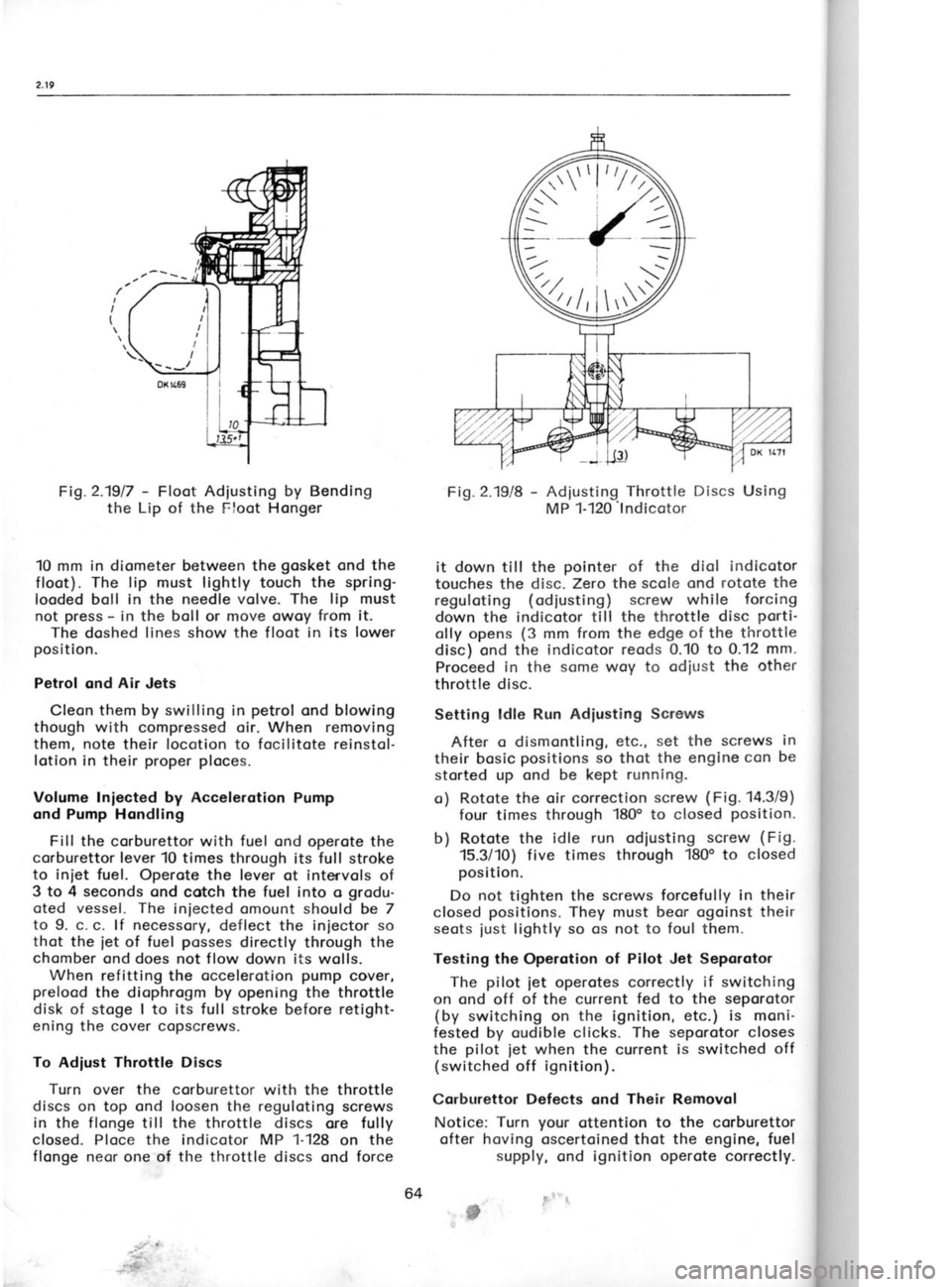
I
I
( 1. Excessir
- overfloc
o) leoky n
b) too higl
- incorrec
c) too lorg
d) too sm<
e) oir-ventl
2. lncorrecl
- engine
o) choked
chokedi ncorrec
defectiv
- errotic i
e) portiolly
f) folse oir
l ncorrec
too low
lncorrect i ncorrec
i ncorrec
c) choked
4- Poor occ
chokedleoky no
defectivr
Loss of p
stoge | |
choked ,
domoge<
i ncorrect
stoge | | mutuolly
ond ll in
Engine w
storti ng
choked <
low fuel
i ncorrect
( excessir
o) lf no nera
hold the
connecte
emergen(
Fi1.2.1917
-
Floot Adjusting by Bending
the Lip of the Floot Honger
10 mm in diometer between the gosket
ond the
floot). The lip must lightly
touch the spring-
looded boll in the needle volve. The lip must
not press -
in the boll
or move owoy from it.
The doshed lines show
the floot in its lower
position.
Petrol and Air
Jets
Cleon them by swilling
in petrol
ond blowing
though with compressed oir. When removing
them, note
their locotion to focilitote reinstol-
lotion in their proper ploces.
Volume Iniected by Accelerotion Pump
ond Pump Hondling
Fill the corburettor with fuel
ond operote the
corburettor lever 10 times through its full stroke
to iniet fuel. Operote the lever ot intervols
of
3 to 4 seconds
ond cotch the fuel into o grodu-
oted vessel. The
iniected omount should be 7
to 9. c. c. lf necessory,
deflect the injector so
thot the
iet of
fuel posses
directly through the
chomber ond does not flow down its
wolls.
When refitting the occelerotion pump
cover,
prelood the diophrogm by opening the throttle
disk of stoge I to its full
stroke before retight-
ening the cover copscrews.
To Adiust Throttle Discs
Turn over the corburettor
with the throttle
discs on top ond loosen the reguloting screws
in the flonge till
the throttle discs ore fully
closed. Ploce the indicotor MP 1-128
on the
flonge necr one of tlre throttle
discs ond force Fig.
2.19/8 -
Adjusting Throttle Discs Using
MP 1-120'lndicotor
it down till the pointer
of the diol indicotor
touches the disc. Zero the scole ond rotote the
reguloting (odiusting)
screw while forcing
down the indicotor till the throttle disc porti'
olly opens (3
mm from the edge of the throttle
disc) ond the indicotor reods 0.10 to 0.12 mm.
Proceed in
the some woy to odiust the other
throttle disc.
Setting ldle Run Adiusting Screws
After o dismontling, etc., set the screws in
their bosic positions
so thot the engine con
be
storted up ond be kept running.
o) Rotote the oir correction screw (Fig.
14.3/9)
four times through 180" to closed position.
b) Rotote the idle run odiusting screw (Fig.
15.3/10) five times through 180o
to closed
position.
Do not
tighten the screws forcefully in their
closed positions.
They must beor ogoinst their
seots iust lightly so
os not to foul them.
Testing the Operotion of Pilot Jet Seporotor
The pilot jet
operotes correctly if switching
on ond off of
the current fed to the seporotor
(by switching on the
ignition, etc.) is moni-
fested by oudible clicks. The seporotor closes
the pilot
iet when
the current is switched off
(switched off ignition).
Corburettor Defects ond Their
Removol
Notice: Turn your
ottention to the corburettor
ofter hoving oscertoined thot the
engine, fuel
supply, ond ignition operote correctly.
# b)
c)
d)
s) h)
3. o)
b)
o)
b)
c)
5.
o)
b)
;i
6.
o)
b)
c)
//"\
'//
\
/\\
-.--- rrr)
V,I rV
64
Page 78 of 238
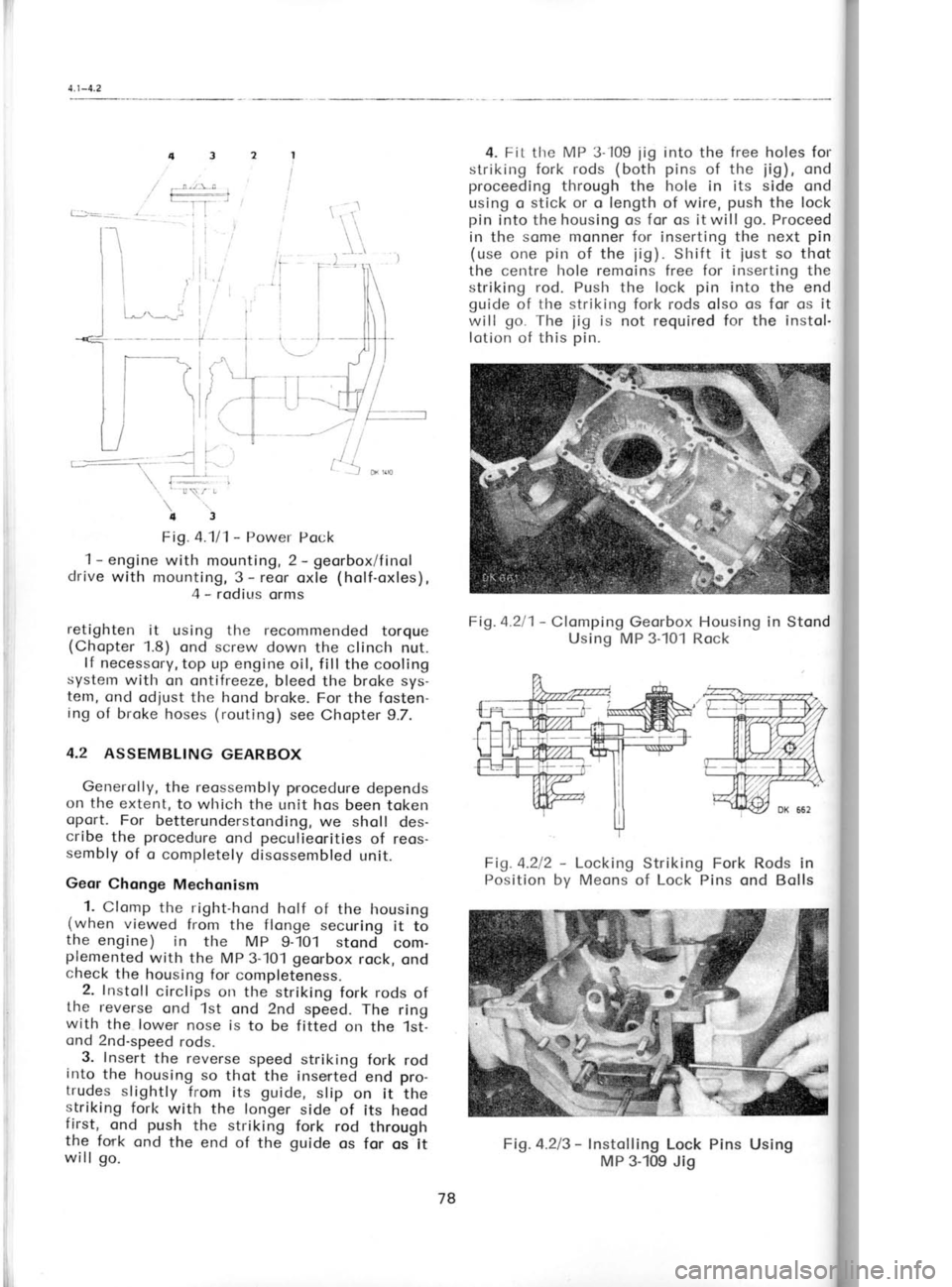
r
t
i
5. Prc
scri bed
rods onc
4th spee
fork rod,
irr the b
6. lnsl
guide bu
cover inr heods. S
tob wos
edges of
F it thr
stri ki ng
weoker s
ing forks 7. Tigl
the forks fork rod
the strik
function
Reverse-:
Fig
-1 - Rever
2-1st-o
3-3rd- o
4 -
Rever
8. Inst
press-f ittr
verse-spe
inside th
through t
Turn tl'
end foces
lock it in
hole. Tigl
Pinion Ar
9. Instc
ing ond,
r
_-_-- -
. i\:r,,,
\. 43
Fig. A.1l'l -
Power Pock
1 -
engine with mounting, 2 -
georbox/f inol
drive with
mounting, 3 -
reor oxle (holf-oxles),
4 -
rodius orms
retighten it using the recommended torque
(Chopter 1.8) ond screw down the clinch nut.
lf necessory, top up engine oil, f ill the cooling
system witlr on qntifreeze,
bleed the broke sys-
tem, ond
odiust the hond broke.
For the fosten-
ing of broke hoses (routing)
see Chopter 9.7.
4.2 ASSEMBLING
GEARBOX
Generolly, the reossembly
p'rocedure
depends
on the extent, to wlrich the unit hos been token
oport. For betterunderstonding,
we sholl des-
cribe the procedure
ond peculieorities
of reos-
sembly of o completely
disossembled unit.
Gear Chonge Mechonism
. 1.
Clomp the right-hond holf of the housing
(when viewed from the flonge securing
it to
the engine) in the MP 9-101 stond
com-
plemented with the MP 3-101 georbox
rock, ond
check the housing for completeness.
2. Instoll
circlips on the striking fork rods
of
the reverse
ond 1st ond 2nd speed. The ring
with the lower
nose is to be fitted
on the 1st--
ond 2nd-speed rods.
3. lnsert the reverse speed
striking fork rod
into the housing
so thot the inserted
end pro-
trudes slightly from its guide,
slip on it the
striking fork with the longer
side of its heod
first,- ond push
the striking fork rod through
the fork
ond the end of the guide
os for os=it
will go. 4. Fit tlre
MP 3-109 jig
into the free holes for
striking fork rods (both pins
of the
iig), ond
proceeding through the hole in its side ond
using o stick or o length of wire, push
the lock
pin into the housing
os for os it will go.
Proceed
in the some monner for
inserting the next pin
(use one pirr
of the
iig). Shift
it
iust so thot
the centre lrole remoins free for inserting
the
striking rod.
Puslr the lock pin
into the end
guide of the strikirrg
fork rods olso os for os it
will go. The
iig is not required
for
the instol-
lqtion of this pin.
Fig.4.2l1- Clomping Georbox Housing in Stond
Using MP 3-101 Rock
Fig.4.212 -
Locking Striking Fork Rods in
Position bv Meons of Lock
Pins ond Bolls
78 Fig.4.2l3
-
Instolling Lock Pins Using
MP 3-109 Jig
Page 90 of 238
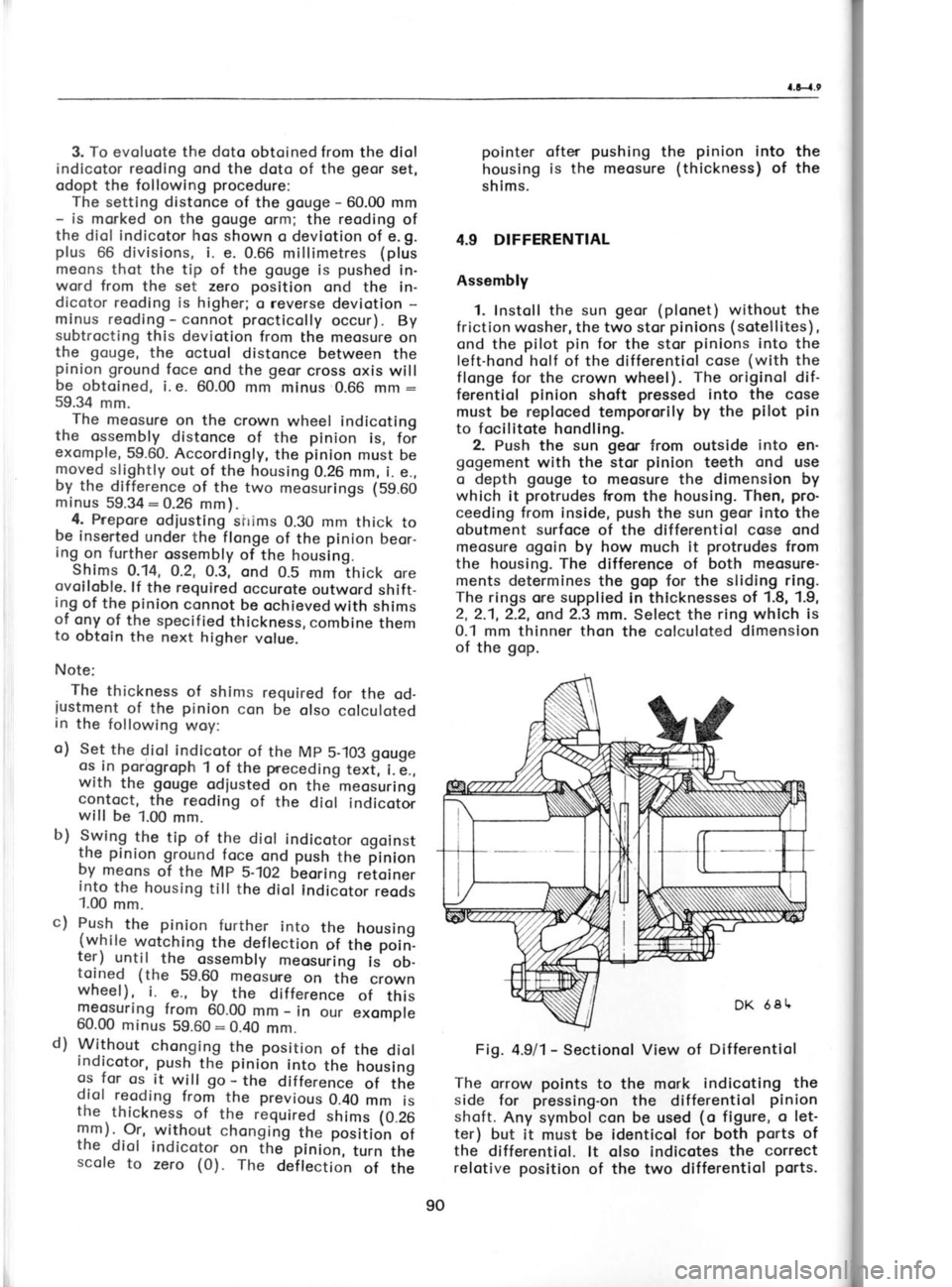
^l;
eil
ell
€; \l-
I
4.9-4.
r
O
Fig. I
((
,'.ffi
l|i
3. To evoluote
the doto
obtoined from
the diol
indicotor reoding ond the
doto of the geor
set,
odopt the following procedure:
The setting distonce of the gouge -
60.00 mm
- is morked on the gouge
orm; the reoding
of
the diol indicotor
hos shown
o deviotion
of e. g.
plus 66 divisions, i. e. 0.66 millimetres (plus
meons thot the tip
of the gouge is pushed
in-
word from the set zero position
ond the in-
dicotor reoding is higher;
o reverse deviotion -
minus reoding -
connot procticolly
occur). By
subtrocting this deviotion from the meosure on
the gouge, the octuol distonce between the
pinion ground foce ond the geor
cross oxis will
be obtoined,
i. e. 60.00 mm minus 0.66 mm :
59.34 mm.
The meosure on the crown
wheel indicoting
the ossembly
distonce of the pinion
is, foi
exomple, 59.60. Accordingly,
the pinion
must be
moved slightly
out of the housing
0.26 mm, i.
e.,
by the difference
of the two
meosurings (59.60
minus 59.34:0.26 mm).
4. Prepore
odiusting
sirims 0.30 mm thick to
be inserted
under the flonge
of the pinion
beor-
ing on further
ossembly of the housing.
Shims 0.14, O.2, 0.3, ond 0.5 mm thick ore
ovoiloble. lf the required
occurote outword shift-
ing of the pinion
connot be ochieved
with shims
of ony of the specif
ied thickness, combine them
to obtoin
the next higher
volue.
Note: The thickness of shims required
for the od-
iustment of the
pinion
con be olso
colculoted
in the following
woy:
o) Set the diol indicotor
of the Mp 5-103 gouge
os in porogroph
1of the preceding
texi i.6.,
with the gouge
odiusted on the meosuring
contoct, the reoding
of the diol indicoto-r
will be 1.00 mm.
b) .Swing the
tip of the diol
indicotor
ogoinst
the pinion ground foce ond push
the
iinion
by meons
of the Mp 5-102
beorinq
retoiner
into the housing
till the diol
indicitor reods
1.00 mm. pointer
ofter pushing
the pinion
into the
housing is the meosure (thickness)
of the
shims.
4.9 DIFFERENTIAL
Assembly 1. Instoll the sun geor (plonet)
without the
friction wosher, the two stor pinions
(sotellites),
ond the pilot pin
for the stor pinions
into the
left-hond holf of the differentiol cose (with
the
flonge for the crown wheel). The originol
dif-
ferentiol pinion
shoft pressed into the cose
must be reploced tempororily by the pilot
pin
to focilitote hondling. 2. Push the sun geor
from outside into
en-
gogement with the stor pinion
teeth ond
use
o depth gouge
to meosure the dimension by
which it protrudes
from the housing. Then, pro-
ceeding from inside, push
the sun geor
into the
obutment surfoce of the differentiol cose ond
meosure ogoin
by how
much lt protrudes
from
the housing. The difference of both meosure-
ments determines the gop
for the sliding ring.
The rings ore supplied
in thlcknesses of 1.8,
1.9,
2, 2.1,2.2, ond 2.3
mm. Select the ring whlch is
0.1 mm thinner thon
the colculoted dimension
of the gop.
Fig. 4.9/1- Sectionol View of Differentiol
The orrow points to the mork indicoting the
side for pressing-on
the differentiol pinion
shoft. Any symbol con be used (o
figure, o let-
ter) but it must be identicol for both ports
of
the differentiol. lt olso indicotes the
correct
relotive position of the two differentiol ports.
c)
d) Push,
the pin-ion further into the housing
{while w.otching
the deflection
of the poin-.
ter) until the ossembly
meosuring
is ob-
toined (the 59.60 meosure
on th; crown
wheel) , i.
e., by the dif ference
of this
meosuring from 60.00
mm -
in our exomple
60.00 minus 59.60:0.40
mm.
Without chonging the position
of the
diol
Indicotor, push
the pinion into the housing
gs for os
it
will go -
the difference
of th6
d.iol reoding
from the previous
0.40 mm is
the thickness
of the required
shims (0.26
mm). Or, without chonging
the position
of
the diol indicotor on tfrJ pinion,
trin tf,e
scole to zero (0).
The
deilection
of the
90 Fig-
Page 95 of 238
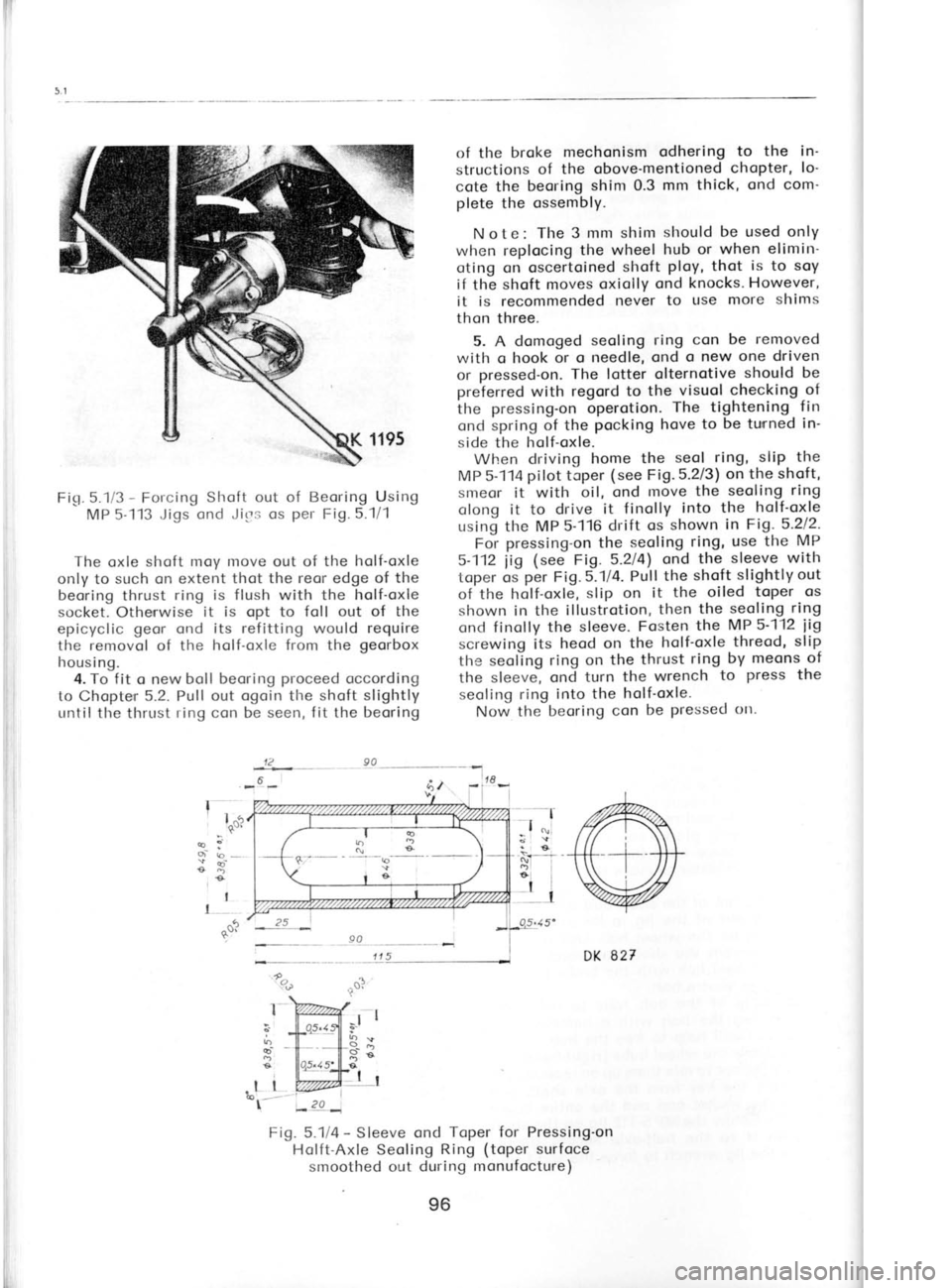
5.
rl in
t-o o
el
st
th
w
ce
re
q
tr
t
Fig.
5.1i3 -
Forcing Slroft out of Beoring Using
MP 5-113 Jigs ond Jirrs os per
Fig. 5."1/1
The oxle shoft moy Inove out of the holf-oxle
only to such on extent thot the reor edge of the
beoring thrust ring is flush
with the holf-oxle
socket. Otherrwise it is opt to
foll out of the
epicyclic geor
ond its refitting would require
the removol
of the holf-oxle from
the georbox
housing. 4. To fit o new boll beoring proceed
occording
to Chopte'r 5.2.
Pull out ogoin
the shoft slightly
until the thrust ring con be seen, fit the beoring
I I
I of the
broke mechonism
odhering to the in-
structions of the obove-mentioned chopter,
lo'
cote the beoring
shim 0.3 mm thick, ond com'
plete the ossembly.
Note: The 3 mm shim should
be used only
when replocing the wheel hub or when elimirr-
oting on oscertoined shoft ploy,
thot is
to soy
if the shoft moves oxiolly ond
knocks. However,
it is recommended never
to use more shims
thon three.
5. A domoged seoling
ring con be removed
with o hook or o needle, ond o new one driven
or pressed-on.
The lotter olternotive should be
preferred with regord to the visuol checking of
the pressing-on operotion. The
tightening fin
ond spring of the pocking
hove to be
tunned in-
side the holf-oxle.
When driving home the seol
ring, slip the
MP 5-114 pilot toper (see
Fig.5.213) on the
shoft,
smeor it with oil, ond move the seoling
ring
olong it to drive it finolly into the holf-oxle
using tlre MP 5-116 drift os shown in Fig-
5-212.
For pressing-on
the seoling ring, use the MP
5-112 iig (see
Fig. 5.214)
ond the, sleeve
with
toper os per
Fig.5.-1l4. Pull the shoft
slightly out
of'the holf-oxle, slip
on it the oiled toper os
shown in the illustrotion, then the
seoling ring
ond finolly the sleeve. Fosten the MP 5-112
iig
screwing its heod on
the holf-oxle threod, slip-
the seoling ring on
the thrust ring
by meons of
the sleeve, ond turn the wrench to
press
the
seoling ring into the holf-oxle.
Now the beoring con
be pressed ott.
l^5
oi ro --
€D
.90 DK 827
4 '%
I i5
t"'
I
-l
b
F)
g
d
e \
r
e
.l I
€['----
Fig. 5.1i4 -
Sleeve ond Toper for Pressing'on
Holft-Axle Seoling Ring (toper
surfoce
smoothed out during monufocture)
12
90
6"44 t;)
20 96
Page 97 of 238

5.:
pr
stl
bc
5-t
bo
thr
u*,
on
dit
on arI
ioi
sPl
SW
I
gor
:
wo
bol
cyl
del
\
mo
th€ hot
WO
F
clo
POS +:
nec
wol
reo
toe
wit
T
o)
b)
Alil 1.
con
sloc
seo'
int
Fig.5.2l5
-
Pressing Boll Beoring
on Shoft
Using MP 5-112 Jig ond
lts Liner (smoller)
Fig.5.216 -
Connection of
Holf-oxles
with Rodius Arms
lorger ond one smoller, ond the forked plote),
screw down the
iig on the threod
of the shoft,
ond use
nuts to ottoch it
to the holf-oxle socketf
longe. The
iig of
the lotest design permits
its
simple fostening by engogement with
the holf-
oxle flonge (fit
the
iig ond
rotote
it to lock it
in position).
Instoll the lorger liner between the boll
beor-
irrg ond the
iig heod, ond
press
the boll
beorirrg
on the shoft by turning the iig wrench.
3. Reploce the lorger liner with the smoller
one (rest it ogoinst the
iig bolt heod), ond turn
the wrench in the opposite direction to press
the beoring into the holf-oxle socket.
Fitting Broke Mechonism ond Wheel Hub
4. Instoll the broke bocking plote
complete
with the broke
mechonism on the holf-oxle
socket, slip on the "O"
seoling ring ond the
cop with the seoling ring (with
the tightening
f in focing toword the holf-oxle), ond fosten
oll
the porrts
with bolts, spring woshers, ond
nuts.
The seoling ring should be driven or pressed
into the cop so thot the tightening lip foces the
beoring ond
iust so thot there
remoins
o gop
of
1 to 2 mm between the pocking
ond the cop
f longe.
5. lnsert the key in
the shoftwith its bevelled
end into the runout of the keywoy, smeor
the
hub neck with oil so
thot it does not
drog in
the seoling ring, ond fit the hub with the broke
drum in position.
Moke sure thot the key did
not move further olong the shoft (its
lifted end
in the keywoy would couse the hub to burst)
ond tighten
lightly the nut. Since o high
torque
is required
for finol tightening of the nut, put
off the tightening ond locking of the nut till
ofter instollotion in the cor. Then
tighten the
nut with full torque (see
Chopter 1.8),
top on
the hub to relieve
the possive
stress of the
toper, retighten to the specified torque, ond
lock the nut with o cotter pin.
Fitting Rodius Arms
6. Instoll
the spocer into the rodius
orm, fit
the knurled
woshers (with
the knurling toword
the orm)
to either side of the ellipticol holes of
the rodius
orm, ond fosten them with bolts ond
nuts not
forgetting the spring woshers. Do not
tighten the connection fully. Threod
the bolts
through the bolt holes so thot their nuts foce
into the cor ofter fitting the rodius orm to the
holf-oxle.
Fit the rodius
arm on the protruding
holf-oxle
pin ond threod
the bolt through the hole
of the
secrt. Slip
spocing tubes on the bolt ond pin
together with sheet shims with rubber liners
ond fosten
lightly (without tightening)
the
rodius orm to the holf-oxle using nuts
ond lock
woshers. Tighten
fully the connection
ofter fit-
ting the ossembly
in the cor when odiusting
the
reor wheel
olignment (geometry).
il
i
ii
I
I
I
I
lr
il
H, DK
?EI
98
Page 105 of 238

wi
prl
tht
rer
oul MT
ott
rec
.a
Fig
Dis S
boll
6-1C
rubl
ovo
exomple
50,000 km ond
more, check the wheel
comber ond prepore
suitoble woshers for its
correction. 2. Jock up the cor ond support the body on
both sides to relieve the front wheels, ond
remove the wheels. 3. Proceeding from
inside the luggoge boot,
remove covers protecting
the threods of the
shock-obsorber piston
rods ond screw off the
nuts. Retoin the piston
rod by holding its flot-
tened end.
b) Operotions inside the cor
4. Remove the steering wheel, the steering
column cowling, ond detoch the steering
shoft
from the body -
see Chopter 7.8.
c) Operotions from under the cor
5. Remove the bolt of the connection of the
steering shoftwith the steering box ond releose
the shoft sleeve from the connection by pull-
ing the steering geor
inside the cor.
6. Slocken the nuts of the bottom wishbone
pins fostening the front oxle to the brocket on
the body until the woshers of the brockets ore
releosed. 7. Detoch the onti-roll bor brockets from
the
body ond disconnect the rubber broke hoses
from the front broke systems.
Before discon-
necting the hose, cleon thoroughly the hose
connector ond its surroundings to prevent
foreign motter from getting
into the broke
system. For the some reoson,
wrop the
hose
ends in o cleon rog. Toke
the some precoutions
with the disconnected broke piping.
8. Ploce o roll-o-cor
iock under the oxle ond
remove the bolts (two
on either side
of the tele-
scopic shock obsorber) fostening the oxle to
the body from obove. 9. Compress the telescopic shock obsorbers,
lower the
iock, ond
move it with the oxle from
under the cor.
6.3 REFITTING FRONT AXLE IN
CAR
1. To reinstoll the oxle in
the cor, reverse the
procedure of its removol, i.
e., begin with the
porogroph 9 ond proceed
to the porogroph
1.
Coot the rubber
cup with greose
ot the point
of its contoct with the steering shoft.
2. While reconnecting the broke hoses, ob-
serve the utmost cleonliness ond bleed the front
wheel brokes if no other ports
of the broke
system hos been dismontled. (lf
such o dis-
montling hos token ploce,
bleed the brokes of
oll wheels ofter hoving fully reclosed
the broke
circuit). 3. Turn the wheels in the stroight oheod di-
rection before connecting the steering shoft
with the steering box. Fit the steering wheel tentotively
ond odiust the direction indicotor
switch -
see Chopter 13.17.
4. Using the steering wheel, tunn the wheels
into full lock positions
to moke sure thot the
lock ongle is correctly limited by the king pin
socket stops -
see Chopter 6.5, porogroph
36.
5. Adiust the toe-in -
see Chopter 6.1.
6.4 DISMANTLING
FRONT AXLE
No speciol instructions ore required for
dis-
montling mony of the subossemblies. Accord-
ingly, only the bosic dismontling procedure
will be
deolth with ond porticulors
will be men-
tioned only os fon
os they ore necessory for the
sequence of operotions ond the use of iigs.
Ports which con be dismontled witlrout re-
moving them from the cor ore the wheel hubs
and beorings, the broke mechonisms, steering
orms, shock obsorbers, ond the
onti-roll bor.
lf ony odditionol ports
hove to be dismontled,
remove the oxle from the cor ond dismontle it
on the stond.
Dismontling Wheel Hubs
ond Beorings
1. Dismontle the broke mechonism os per
Chopter 9.1 ond remove
the wheel hub
cop
using the MP 6-124 drog. When using the MP
6-136 pull-off
cortridge, the hub cop hos to be
prised off with o
tyre lever or o similor tool.
Now remove the costelloted nutwith its wosher
ond pull
out the hub,
ossisting the removol
with
light blows of o mollet, if necessory.
2. Toke out the inner port
of the outer beor-
ing, then the seoling ring, ond, f
inolly, the inner
port of the reor beoring (cone
with topered
rollers). Prise out the seoling ring using o
scrrewdriver. Proceed corefully olong the ring
circumference to ovoid distorting the ring which
Fig. 6.4/1 -
Removing Hub Cop Using
MP 6-124 Drog
106
Page 107 of 238
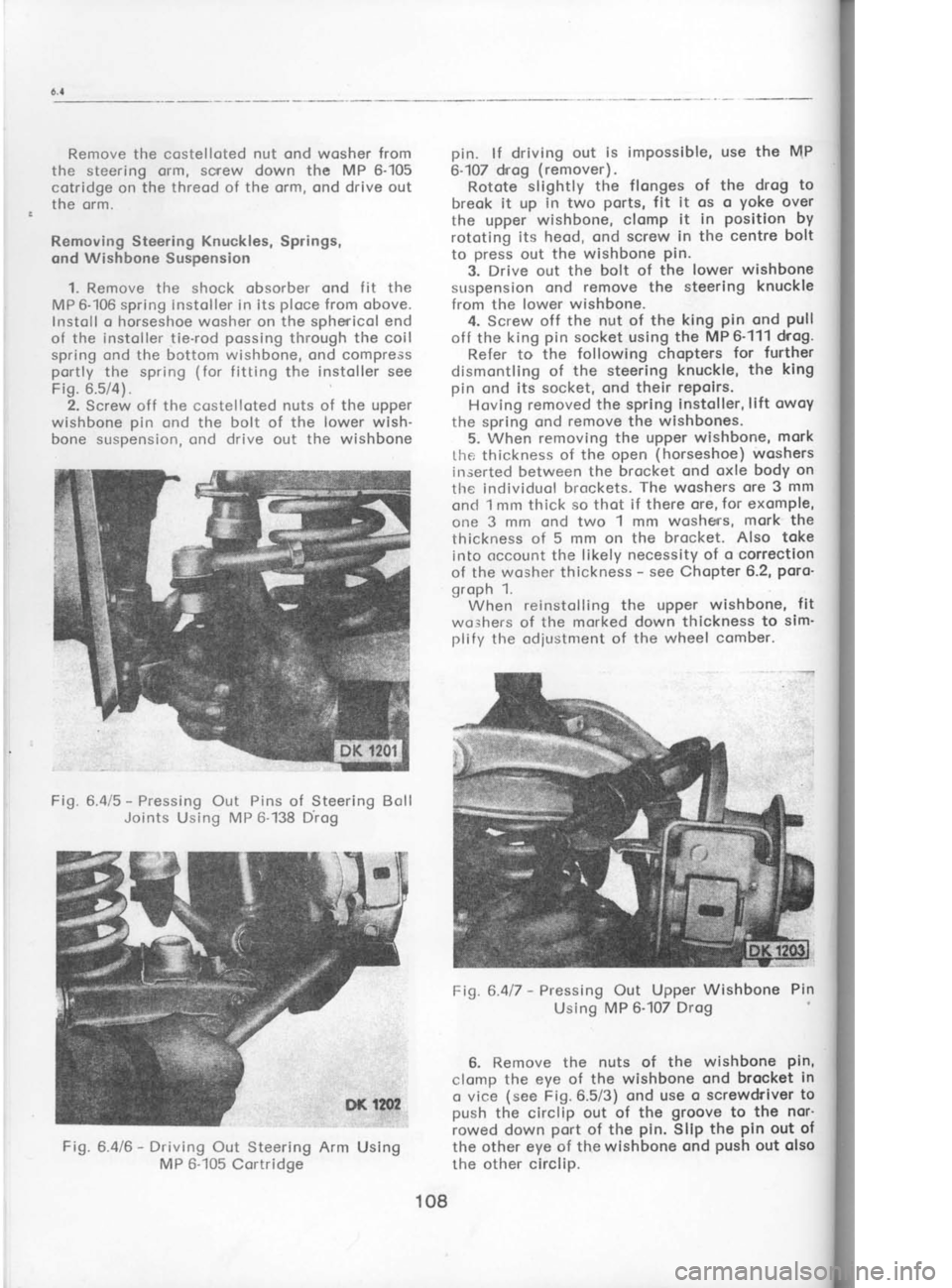
Fig.
Hol
over t
remo!
6.5 F
The
which
provid
$H
Remove the csstelloted
nut ond wosher from
the steering orm, screw down the MP 6-105
cotridge on the threod of the orm, ond drive out
the orm.
Removing Steering Knuckles,
Springs,
ond Wishbone
Suspension
1. Remove tlre shock obsorber ond fit the
MP 6-106 spring
instoller in its ploce from obove.
lnstoll o horseshoe wosher on the sphericol end
of the instoller tie-rod possing
tlrrough the
coil
spring ond the bottom wishbone, ond compress
portly the spring (for
fitting the instoller see
Fig. 6.5/4).
2. Screw off the
costellqted nuts of the upper
wishbone pin
ond the bolt of the lower wish-
bone suspension, ond drive out the wishbone
Fig. 6.415 -
Pressing Out Pins of Steering Bcrll
Joints Using MP 6-138
Drog
Fig.6.416 -
Driving Out Steering Arm Using
MP 6-105 Cortridge pin.
lf driving out is impossible, use the MP
6-107 drrog (remover).
Rotote slightly the
flonges of the drog to
breok it up in two ports,
fit it os o yoke
over
the upper wishbone,
clomp it in position
by
rototing its heod, ond screw in the centre bolt
to press
out the wishbone pin.
3. Drive out the bolt of the lower wishbone
suspension ond remove the steering knuckle
from the lower wishbone.
4. Screw off the nut of
the king pin
ond pull
off the king pin
socket using the MP 6'111 drog.
Refer to the following chopters for
further
dismontling of the steering knuckle, the king
pin ond its socket, ond their repoirs.
Hoving removed the spring instoller,lift owoy
the spring ond remove
the wishbones.
5. When removing the upper wishbone, mork
the thickness of the open (horseshoe) woshers
irrserted between the brocket ond oxle body on
tlre individuol brockets. The
woshers ore 3
mm
onct 1 mm thick so thot if there ore, for exomple,
one 3 mm ond two 1
mm woshe'rs, mork the
thickness of 5 mm on the brocket. Also toke
into occount the likely necessity of o correction
of the wosher thickness -
see Chopter 6.2, poro-
groph 1. When reinstolling the upPer wishbone, fit
wo;hers of the morked down thickness to sim'
plify the cdjustnrent of the wheel comber.
Fig.6.4l7 -
Pressing Out Upper Wishbone Pin
Using MP 6-'107 Drog
6. Remove the nuts of the wishbone pin,
clomp the eye of the wishbone ond brocket in
o vice (see
Fig.6.5/3) ond use o screwdriver to
push the circlip out of the groove
to the nor'
rowed down port
of the pin.
Sllp the pin out of
the other eye of the wishbone ond push
out olso
the other circlip.
108